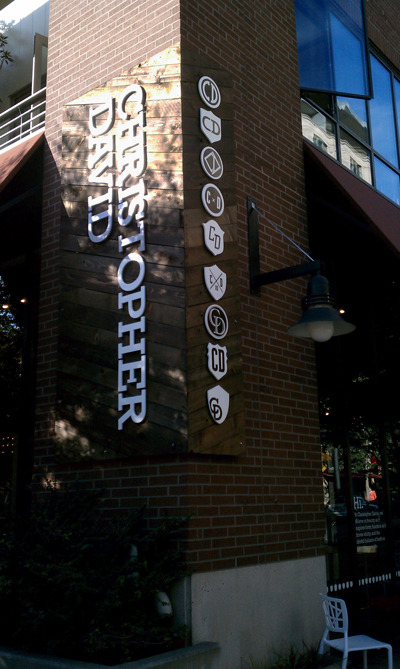It’s always fun to learn the story behind a particular coffee or café. For me, the people behind the coffees, whether farmers, roasters, baristas, café owners—even coffee drinkers—are the most intriguing part of the coffee industry and culture. The coffee is great, and learning about it is interesting, but hearing how much people care about what they do is even better. Such is the case with the story behind Nossa Familia’s newest arrival in the company’s Microlot Series. Since 2005, Nossa Familia (“Our Family,” in Portuguese) has been importing and roasting Brazilian coffees from farms run by the family of Augusto Carvalho Dias Carneiro, the company’s owner. Over the last year, Augusto decided to “extend the familia” beyond his family’s farms and into other countries. The latest of the Microlots comes from Finca San José de las Nubes, in the Matagalpa region of Nicaragua. Finca San Jose’s owner, Bayardo Reyes, has one of those stories I find interesting. --WH
Bayardo Reyes grew up in Matagalpa, Nicaragua, a place his family called home for generations. In the early 1920s, his grandfather, Rigoberto, established a coffee farm in the mountains near Matagalpa. Bayardo’s father, Mauricio, later expanded it, but Bayardo’s prospects of carrying on the family legacy looked tenuous after 1979, when the Sandinistas took power. The new government confiscated the family’s land and divided it up among many campesinos (peasants). Knowing little about farming, the new owners did not tend to the land with the same care, and the land was eventually sold or abandoned.
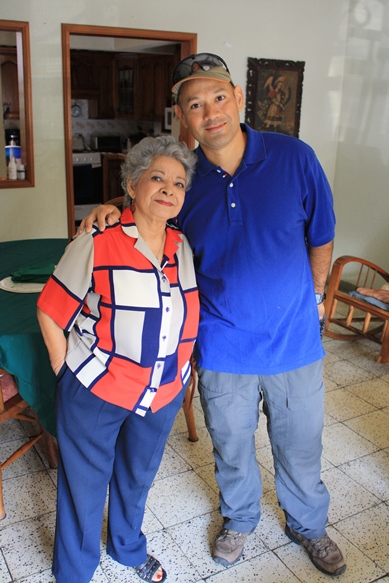 Bayardo Reyes and his mother, Gloria
Bayardo Reyes and his mother, Gloria
Nicaragua’s tumultuous times continued into the eighties, as the country went through a civil war (Americans might remember the televised hearings over the Iran-Contra scandal, where the U.S. was secretly selling arms to Iran and channeling the funds to the anti-Sandinista militias (the Contras) in Nicaragua). In 1984, Bayardo’s father died unexpectedly, a blow to the family. Bayardo was just heading into his teenage years, and his mother, Gloria, feared that her son would be pulled into the conflict by forces on either side of the political divide. To protect Bayardo, she sent him to live with an aunt in Miami. Bayardo attended school in Miami, and after graduating from high school, he enrolled in the U.S. Army in 1991, deploying to Somalia soon thereafter, the first of multiple tours in conflict zones (Reyes also went to Iraq in 2003, 2006, and 2009—so much for a mother’s wish to keep her son out of harm’s way).
While Bayardo felt at home in the United States, he wanted to maintain a connection to his roots in Nicaragua. He harbored many fond memories of being around the coffee farm, and wanted to somehow continue the traditions of his family. “It’s a way of life,” Bayardo told me, when I spoke to him over the phone. Reyes asked his mother, still in Nicaragua, to keep an eye out for an opportunity to buy some land that could produce coffee.
At the time, land was cheap in Nicaragua, and in 1991, Bayardo purchased approximately 150 acres in the Matagalpa region, an area well known for its coffee. The farm, at 1200 meters above sea level, was located in a cloud forest, well-situated for producing coffee. “I wanted to help people around there grow coffee and show them what I learned from my dad and granddad,” Bayardo said.
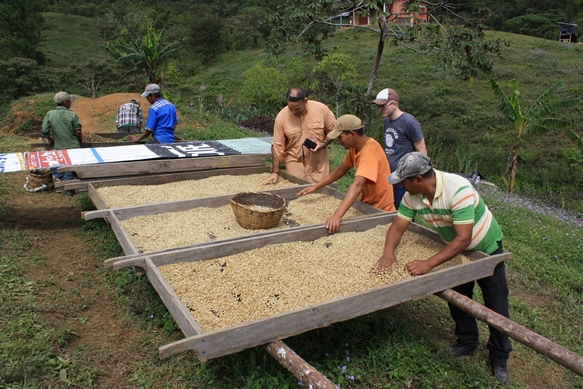 Spreading coffee to dry. Photo courtesy Augusto Carneiro Dias.Military life kept Reyes busy, but Reyes would visit the farm whenever he could, usually 3-4 times each year (except when he was deployed to war zones). Improving the farm was important, but improving the lives of the people in the region was the bigger goal. “The whole thing was never about coffee,” said Bayardo. “It was about helping people, and the coffee made it possible.” After his first stint in the Army, Reyes went to college and studied civil engineering. After getting his degree, Reyes returned to active duty, this time as an officer. Today, Bayardo is a major who specializes in logistics and operations.
Spreading coffee to dry. Photo courtesy Augusto Carneiro Dias.Military life kept Reyes busy, but Reyes would visit the farm whenever he could, usually 3-4 times each year (except when he was deployed to war zones). Improving the farm was important, but improving the lives of the people in the region was the bigger goal. “The whole thing was never about coffee,” said Bayardo. “It was about helping people, and the coffee made it possible.” After his first stint in the Army, Reyes went to college and studied civil engineering. After getting his degree, Reyes returned to active duty, this time as an officer. Today, Bayardo is a major who specializes in logistics and operations.
Although he does not live on the farm, Reyes is able to keep a fairly close eye on what is happening there. Bayardo travels to Nicaragua a few times each year to work on new projects. His mother monitors the checkbook and makes sure things run smoothly in Bayardo’s absence. Reyes contracts with an agronomist to watch over the health of the plants and prescribe any recommendations. The agronomist, who oversees multiple farms in the region, visits Finca San José every couple weeks and sends Bayardo a status report.
To see more pictures of Finca San Jose, including more of the people who live and work there, click here. All photos in gallery courtesy Bayardo Reyes.
The farm has undergone many improvements since the early nineties. When Reyes bought the farm, it had no buildings. Over the years, he has put up some structures, including a few houses for employees who work on the farm. Today, ten people live in the farm’s housing (about thirty people work full-time on the farm). Reyes imported solar panels, car batteries, an alternator and a small wind turbine to charge the batteries and provide some electricity. “It was really neat how Bayardo piecemealed it all together from scratch,” said Augusto, when I spoke with him at Nossa Familia’s headquarters. “He knows he can’t depend on the government to bring in power and water and all that.”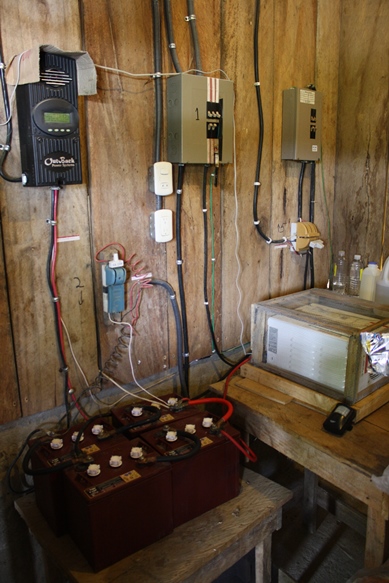 Inside the office. Photo courtesy Augusto Dias Carneiro.
Inside the office. Photo courtesy Augusto Dias Carneiro.
Helping others is an important part of Finca San José. “The U.S. has given me so much,” Bayardo said. “I want to give back, and this place is where I can make an impact.” Reyes has brought in a cupper to teach neighboring farmers how to gauge the quality of their coffees, so they have a better idea of what their coffees are worth, essential knowledge when negotiating with coffee buyers. Reyes has also helped the neighbors access credit to buy chemicals to improve their crops.
Bayardo encourages his employees to improve their education. He provides on-farm classes for both workers and their children. Having educated workers helps the farm run smoother. “How can I make someone a manager if they can’t read or write?” Reyes said. Five days a week, a teacher visits the farm and gives lessons, in a dedicated classroom area.
One of the challenges for farmers in the area is getting their coffees to the mills (beneficios) in a timely manner. Reyes bought a pickup to haul coffees from Finca San José to the mills. When neighboring farmers help Reyes during harvest, he returns the favor by letting them use the pickup to haul their own coffees.
Whenever he can, Bayardo also uses the farm to create employment for the locals. Before he could get the most out of the pickup, Reyes had to improve the main road leading to the farm. Until last year, anyone who wanted to visit the farm had to walk or ride donkeys the last mile. The soils in the area are mostly clay, and when it rains, the roadbed liquefies, making it impassable. As a civil engineer, Reyes knew how to survey the land and design a better road. Primarily, it needed a lot of rock to solidify the soil. He thought about hiring a company to do the work with heavy equipment, but while it would be done quickly, it would not provide as many jobs for people. Since labor costs were relatively low and the physical work was manageable, Bayardo hired a crew to haul gravel and spread it by hand. The crew spent weeks hauling in loads of rock in with the pickup, shoveling rock onto the clay roadway, until finally they made it up to the farm. “Foot by foot they built this road to access the farm,” said Augusto, admiringly.
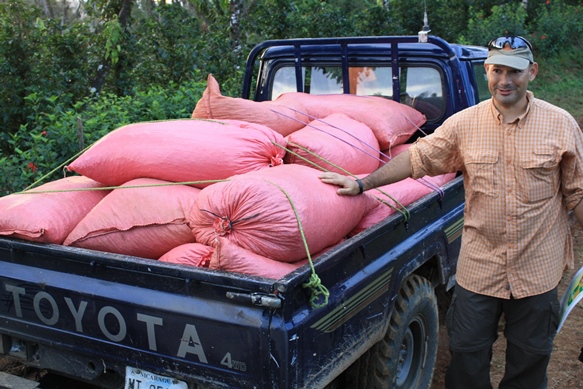 Ready to head to the mill. Photo courtesy Augusto Dias Carneiro.Reyes is careful about protecting Finca San José’s resources. Approximately sixty-five percent of the farm has been set aside for conservation. Part of the farm is also dedicated to producing food and other cash crops for the workers on the farms. Reyes recently put in a gray-water recycling system and improved the toilet facilities, to make living conditions more sanitary. “People there looked at me like I was crazy because I spent $3,000 on a bathroom,” he said. Each new thing adds to the overall impact of Reyes’ efforts. “I can’t help a whole country, but I can concentrate on one region,” he said.
Ready to head to the mill. Photo courtesy Augusto Dias Carneiro.Reyes is careful about protecting Finca San José’s resources. Approximately sixty-five percent of the farm has been set aside for conservation. Part of the farm is also dedicated to producing food and other cash crops for the workers on the farms. Reyes recently put in a gray-water recycling system and improved the toilet facilities, to make living conditions more sanitary. “People there looked at me like I was crazy because I spent $3,000 on a bathroom,” he said. Each new thing adds to the overall impact of Reyes’ efforts. “I can’t help a whole country, but I can concentrate on one region,” he said.
Relationship with Nossa Familia
For years, Bayardo subsidized the farm with his own income, but over the last few years, he has grown the project to a bigger scale, with plans to make it self-sustaining. Production on the farm has grown to 142,000 trees, and costs of running the farm are increasing, so he looked for avenues to increase profitability. In addition to improving the quantity and the quality of the coffees, Reyes also sought out new markets for his coffees. One of the first people he contacted was Augusto. Bayardo’s wife, Yurfa Glenny, had known Augusto since the early 2000s, when they studied together in England. When the SCAA Event was in Portland in 2012, Bayardo and Yurfa came to the show and met with Augusto. The discussions were productive, and it looked like the two sides would get along well.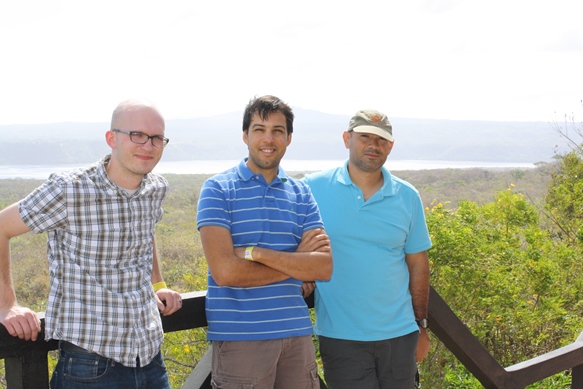 Will, Augusto, and Bayardo. Photo courtesy Augusto Dias Carneiro.
Will, Augusto, and Bayardo. Photo courtesy Augusto Dias Carneiro.
Augusto liked Reyes’ mentality. “Bayardo really wants to focus on quality,” he said. “He’s not doing this because he wants to make a lot from the farm. He’s taking a huge risk, putting all of his savings into this farm.”
Much of the coffee on the farm is shade-grown, which causes it to ripen more slowly and adds to the complexity of the flavors in the coffees. Workers selectively harvest the coffee, to keep underripe and overripe cherries out of the finished product. Reyes says these things are important to potential buyers. “It’s good-quality coffee,” he said.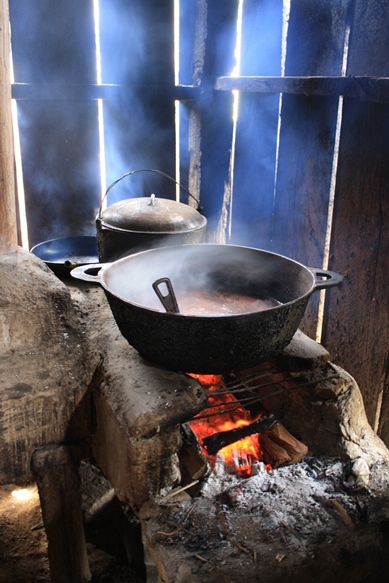 One of Reyes' upcoming projects is to replace the wood stove with a cleaner-burning biogas stove. Photo courtesy Augusto Carneiro Dias.
One of Reyes' upcoming projects is to replace the wood stove with a cleaner-burning biogas stove. Photo courtesy Augusto Carneiro Dias.
In order to be eligible for the Microlot series, at least one of the Nossa Familia employees has to have visited the farm before they will agagree to buy the coffee. In the case of Finca San José, both Augusto and Will Schaefer, Nossa Familia’s head of production and assistant roaster, visited, in January 2013. They arrived just in time for the tercera (the third and final round of harvest, that removes the last of the remaining cherries on the branches). Augusto and Will cupped coffees with Bayardo and selected a few lots to purchase. Nossa Familia bought thirty bags in total this year, with plans to buy more in the coming years.
The thirty bags were far from enough to fill a container, which complicated matters, since the cost to move a container is the same whether it contains thirty or three hundred bags. Augusto called the people at Sustainable Harvest to see if they knew anyone bringing a container in from Nicaragua. In a stroke of luck, Sustainable Harvest itself happened to be bringing in a container from Nicaragua, with extra space for about fifty bags. The timing would be a couple months later than Augusto had originally planned, but the money Nossa Familia saved by splitting the shipping cost with the Portland-based importer was worth it.
After Augusto and Bayardo settled on a price for the coffee, Nossa Familia added $900 to the final agreement, so that Reyes could build three new greenhouses on the farm. The greenhouses double as coffee-drying rooms during harvest. “It improves the quality of the coffee, and allows him to get a higher amount of coffee that’s really high quality,” said Augusto. The greenhouses are used only three to four months out of the year for drying and the other part of the year, they can be used to grow vegetables and new coffee starts. “It’s so humid and there is a risk of rain, so [the greenhouses] remove the risk of rain, increases the area you dry in, and then it has the social benefit of being able to produce better food for the people there,” explained Augusto. “For us, it’s the perfect fit—coffee quality and social aspect, which we really like.”
For Augusto and the Nossa Familia team, adding another country to the lineup adds a degree of complexity to the lineup, but it also adds a new dimension to the coffees that customers can try. The Finca San José coffee will be sold by itself, and also as a component of the company’s Full Cycle espresso blend. (When I tried the Finca San José coffee, it was very chocolaty, with a distinct flavor of orange peel.) Nossa Familia wants to work with growers like Reyes, who share similar values. “We want the coffee to be really good,” said Augusto. “We want it to be from…a place where people are treated fairly, and where we understand the supply chain and are comfortable there’s nobody getting exploited in the middle.”
Working with Nossa Familia is the beginning of a new era for Finca San José. In the future, Reyes wants to partner with additional roasters who share similar values and are also looking for long-term relationships. “I want to have a continuous relationship with people,” Bayardo said. “I want to be able to take people to the farm and show them exactly where their coffee was grown.”
If he can reach a point where the farm pays for itself, Bayardo will be happy. “It’s not about the money,” he said. “It’s about the impact you can have in someone’s life.”
Nossa Familia sells coffees from Finca San Jose at Nossa Familia’s espresso bar, at New Seasons (on a rotating basis), and through the company’s website.
 Friday, October 25, 2013 at 11:12AM
Friday, October 25, 2013 at 11:12AM 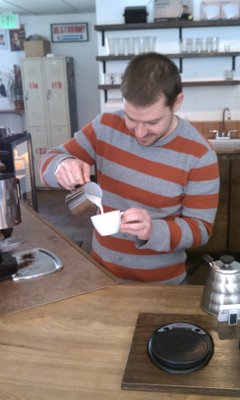 Diveley in action
Diveley in action And the result
And the result


